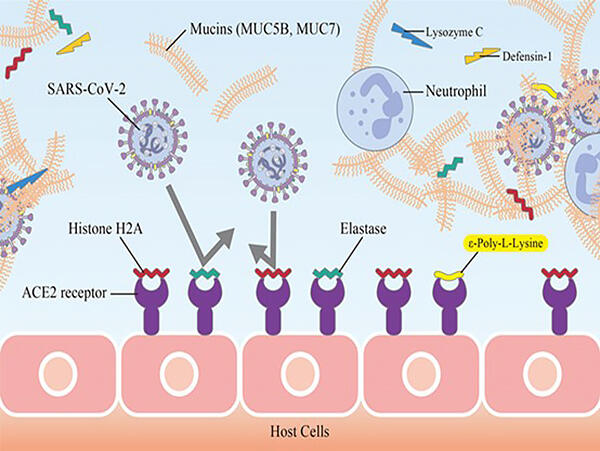The research group of Osaka Metropolitan University Associate Professor Misako Matsubara of the Department of Veterinary Science in the Graduate School of Veterinary Science and of Specially Appointed Professor Katsutoshi Yoshizato of the Hepatology Department and Donated Laboratory for Synthetic Biology in the Graduate School of Medicine conducted binding experiments between S1 and ACE2, and found that saliva from non-SARS-COV-2 infected (healthy) subjects inhibited the binding of S1 and ACE2 in a concentration-dependent manner. In addition, the research group identified, via biochemical methods, four proteins in saliva that bind to ACE2, and of them, elastase and histone H2A, have cationic properties associated with neutrophils (a type of white blood cell), markedly inhibited the binding of S1 and ACE2.

Provided by OMU
COVID-19 (SARS-CoV-2) establishes infections by binding the spike protein S1 on the viral envelope to the angiotensin-converting enzyme 2 (ACE2) receptor present on the plasma membrane of human cells. The onset of COVID-19 infections has a clear age dependency, and it is known that the infection rate in the elderly is significantly higher than in young people and children. However, despite such a significant difference, there is no scientific basis that can fully explain this age dependency. On the other hand, it has been reported that "decreased saliva production" is more pronounced in the elderly, and that the quantity and quality of saliva changes over time.
Based on this, the research group hypothesized that "saliva has a mechanism that prevents SARS-CoV-2 from entering the body." From that hypothesis, they used biochemical methods to show that histone H2A and neutrophil elastase, two cationic proteins in the saliva of healthy individuals, coat the negatively charged molecular surface of ACE2, thereby creating a barrier to entry by SARS-CoV-2. Furthermore, bovine histones exhibit a binding inhibitory effect that is similar to that of histone H2A, which suggests that the histone effect transcends species and that cationic ε-poly-L-lysine, a product of bacterial fermentation, strongly inhibits the binding of S1 and ACE2.
According to Associate Professor Matsubara, "From protein binding experiments, this study showed that saliva may be involved in biological defense mechanisms. In the future, we plan to verify the effectiveness of cationic synthetic peptides while also conducting epidemiological studies on the amount of these salivary proteins and SARS-CoV-2 infection rates. Based on the results of this research, we would like to contribute, to the development, through innate immunity levels, of methods to prevent not only COVID-19, but also unknown viral infections."
This article has been translated by JST with permission from The Science News Ltd.(https://sci-news.co.jp/). Unauthorized reproduction of the article and photographs is prohibited.




